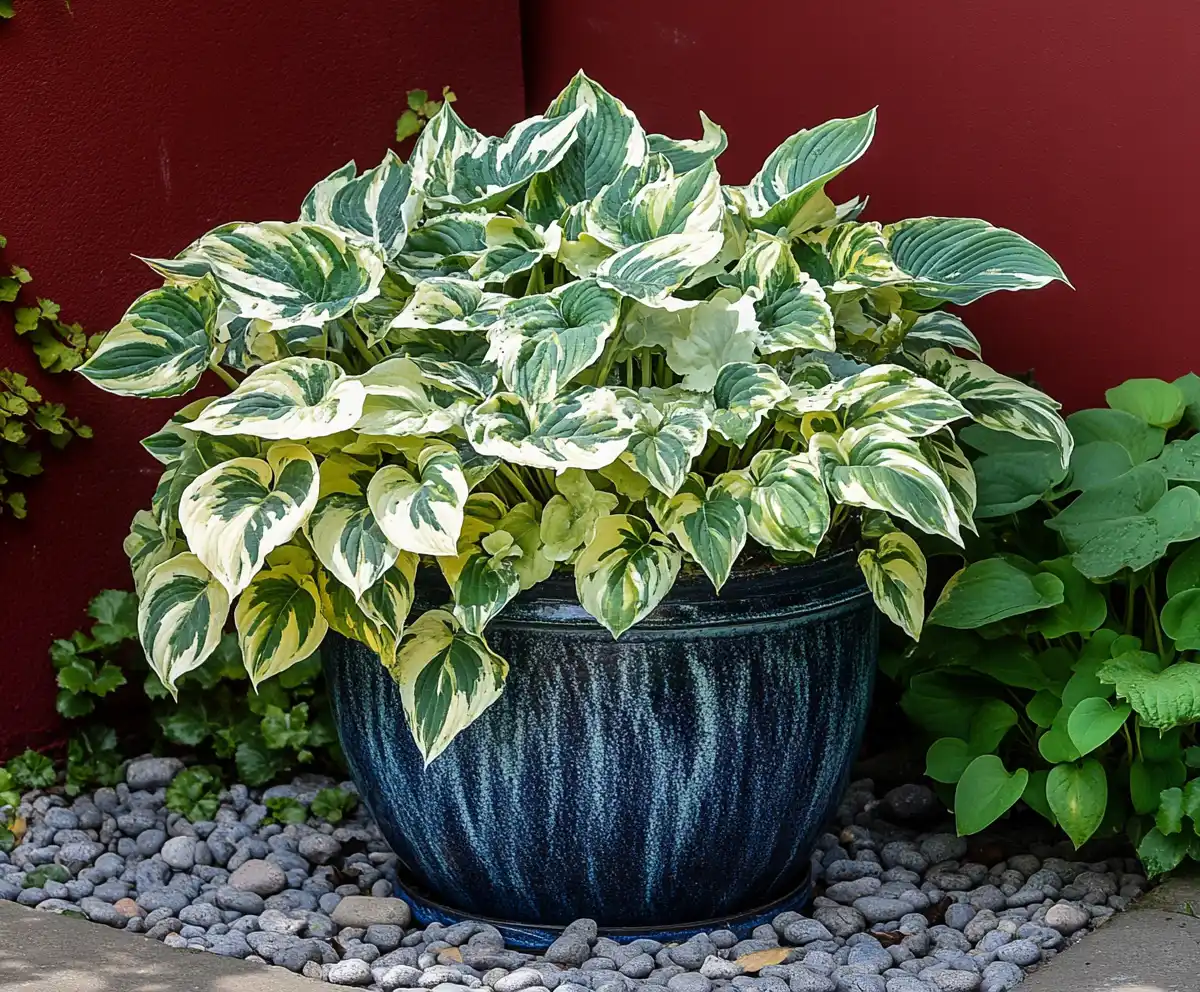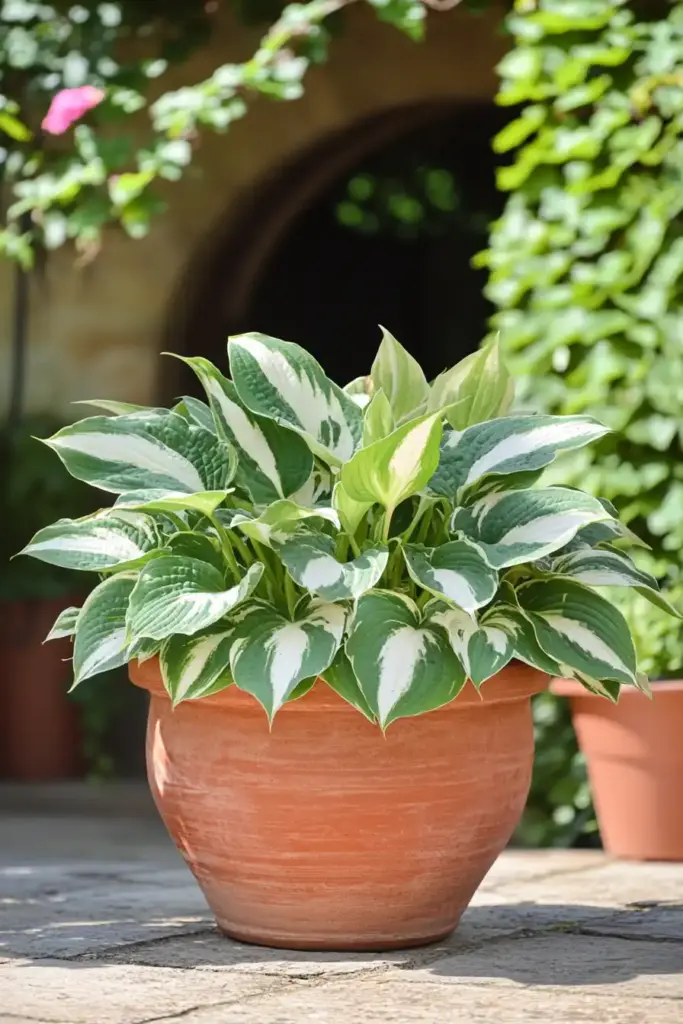Hostas in containers are a brilliant solution for adding lush texture and vibrant foliage to shaded patios, porches, or garden corners where other plants often underperform. Their striking leaves and reliable growth make them a top pick for container gardening—just like the outdoor potted plants featured here that thrive even in tricky spots.
One of the biggest advantages of growing hostas in pots is the flexibility to reposition them based on seasonal light or weather conditions. This also helps reduce common garden pests like voles. For even more visual interest, you can take inspiration from these front porch flower pot ideas to creatively showcase your hostas and boost curb appeal.
Whether you’re working with limited garden space or simply love the look of container-grown foliage, this guide will cover all the essentials to help your hostas in containers thrive beautifully all season long.
🌿 Love gardening inspiration? Follow me on Pinterest for bold plant ideas, tips, and seasonal color!
Table of Contents
🪴 1. Choose a Good Container
Choosing the right pot is a foundational step when growing hostas in containers. Since these plants have horizontally spreading roots rather than deep ones, your container should be wider than it is tall to accommodate their natural growth habit.
Here’s what to look for in the ideal container:
✅ Size Matters
- Select a pot based on the current size of your hosta, not its eventual growth.
- Leave at least 3 inches of space between the plant’s base and the edge of the container.
- If you’re starting with a smaller hosta, you can size up later as it matures.
✅ Material Considerations
- Avoid black plastic or metal pots, which can overheat and damage the roots.
- Opt for:
- Glazed ceramic
- Recycled plastic
- Fiberglass
- Pressure-treated wood
💡 Tip: Glazed ceramics are especially good for retaining moisture and staying cool.
✅ Drainage Is Non-Negotiable
Hostas don’t tolerate soggy roots. Ensure your container has ample drainage holes. If using a decorative pot without holes, drill your own or use it as a cachepot with a draining nursery pot inside.
✅ Reduce Weight Smartly
Using a tall pot? Place an empty sealed plastic bottle at the bottom to save on soil and lighten the load.
Choosing the right container doesn’t just set your hosta up for healthy growth—it also opens the door to creative design possibilities.
🌱 2. Use the Right Soil
The soil you choose can make or break your success with hostas in containers. Fortunately, growing in pots gives you full control over the growing medium—no need to amend your native garden soil.
🌿 Ideal Soil Characteristics
Hostas thrive in a soil mix that is:
- Loamy
- Well-draining
- Moisture-retentive
- Nutrient-rich
Most high-quality all-purpose potting mixes will do the trick. But if you want to take it a step further, enhance your mix with:
- Rice hulls (eco-friendly option to improve drainage and aeration)
- Sphagnum peat moss (helps retain moisture, though less sustainable)
🛑 Avoid heavy garden soil—it compacts easily and can suffocate roots in containers.
🌸 Mulch for Moisture
After planting, apply a thin layer of mulch on the surface to help conserve moisture and regulate temperature. Great mulch options include:
- Straw
- Coffee hulls
- Fine bark or shredded leaves
- Decorative pea gravel
This added layer will also reduce weeds and give your container a tidy look.
💡 Bonus Tip:
If you live in a hot or windy climate, you may want to choose a water-retentive potting mix or mix in water-absorbing crystals to reduce how often you’ll need to water.
💧 3. How to Grow Hostas in Containers
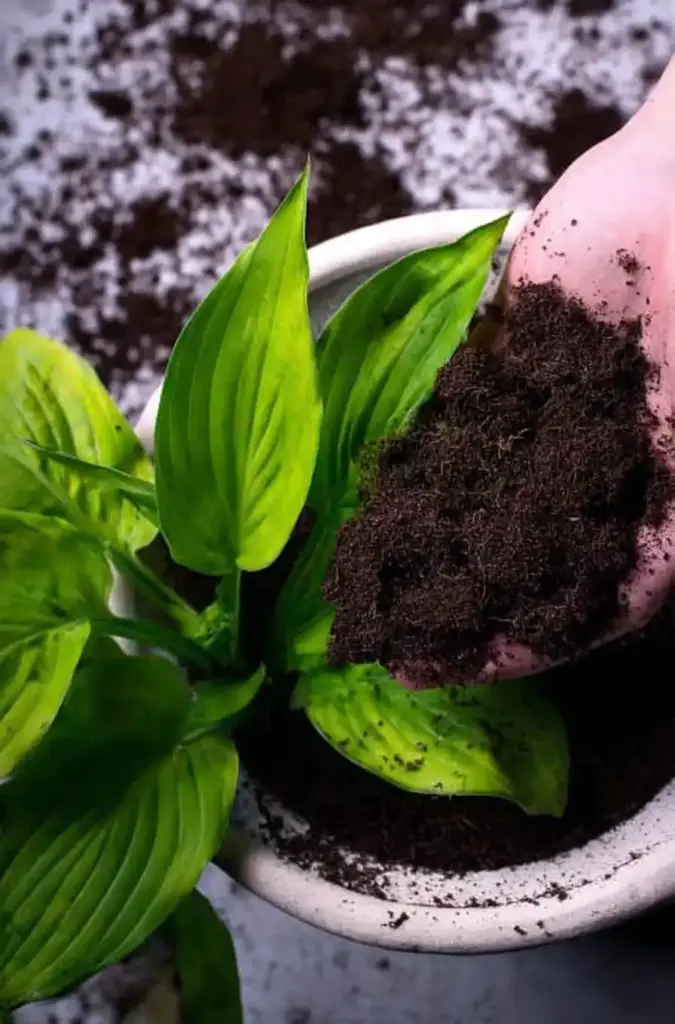
Once you’ve chosen the right pot and soil, it’s time to focus on how to keep your hostas in containers happy and thriving. While these plants are relatively low-maintenance, they do have a few specific needs when grown in pots.
💦 Watering Tips
Container hostas dry out faster than in-ground plants, especially during summer. Here’s how to keep them hydrated:
- Check soil moisture regularly—water when the top inch feels dry.
- Water at the base to avoid wetting the leaves, which can lead to disease.
- During hot months, watering once a day may be necessary.
- Mulch helps retain soil moisture and keeps roots cool.
💡 Pro Tip: Invest in a drip irrigation system or a self-watering container if you travel often or live in a dry climate.
🐌 Pest Watch
Even though pots reduce some pest risks, they aren’t a magic shield:
- Slugs and snails can still find their way up and nibble leaves.
- Use copper tape, diatomaceous earth, or organic slug repellents.
- Voles, however, are rarely an issue with container-grown hostas—one big win for pots!
Keeping an eye on moisture and guarding against pests will give your hostas in containers a strong chance to flourish throughout the season.
🛠 4. Maintain Your Plants
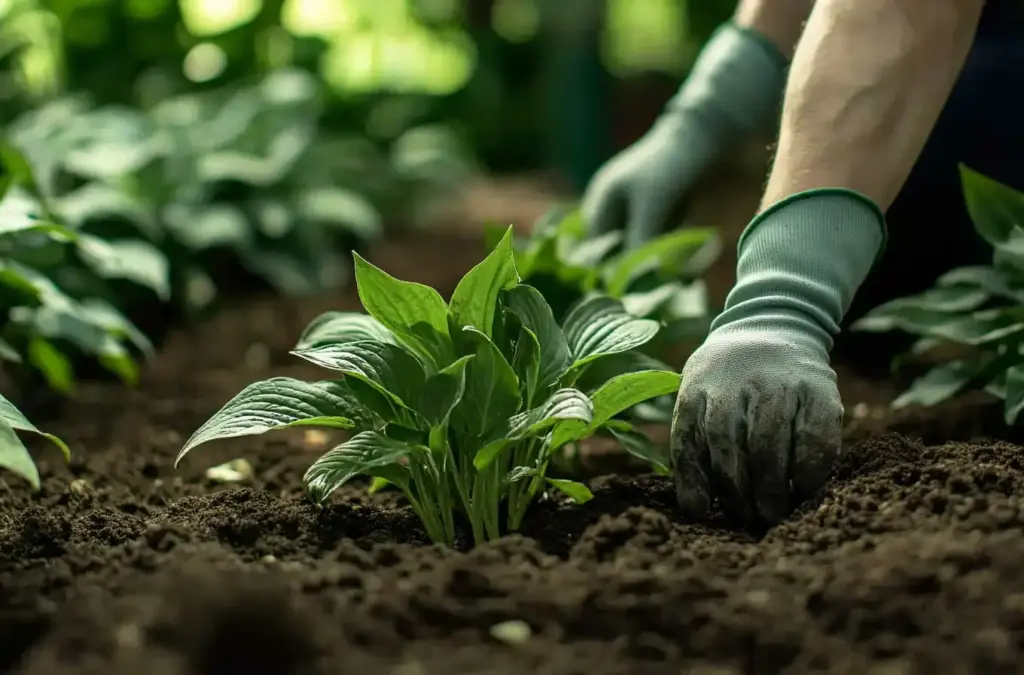
Maintaining hostas in containers is key to keeping them vibrant year after year. While they’re fairly resilient, container-grown plants need a bit more attention than their in-ground counterparts.
🔁 Repotting and Dividing
As your hosta grows, its roots will eventually outgrow the pot. Signs it’s time to repot or divide include:
- Roots circling the soil surface or growing out of drainage holes
- Leaves appearing smaller or growth slowing down
- The plant base touching the edge of the container
Repotting Tips:
- Choose a container one size larger
- Gently remove the plant by tipping the pot and wiggling it free
- Trim any dead or circling roots before replanting
- Refresh with new, nutrient-rich soil
Dividing:
- Cut through the crown with a sharp knife or pruners
- Each division should have at least one healthy “eye” or shoot
- Pot divisions separately for fuller plants
💡 Miniature hostas may not need dividing as often but still benefit from fresh soil every 2–3 years.
🌱 Fertilizing
Potted hostas need more frequent feeding than those in the ground due to nutrient leaching from watering.
- Use a balanced slow-release fertilizer or apply a liquid fertilizer every 2–3 weeks
- Always fertilize at the soil level, not on the foliage
❄️ Winter Dormancy
Hostas are hardy, but they require a period of dormancy to thrive long-term.
- Do not bring indoors into heated spaces—they need cold temps below 40°F for at least a month
- Overwintering options:
- Place pots in an unheated garage or shed
- Leave outside covered with pine boughs or mulch for insulation
- Water sparingly while dormant—only when soil is completely dry
🛡️ If your variety is hardy to one zone colder than yours, you likely don’t need extra protection after the first year.
Keeping up with seasonal maintenance ensures your hostas in containers will reward you with lush foliage and graceful beauty year after year.
🌼 5. Best Uses
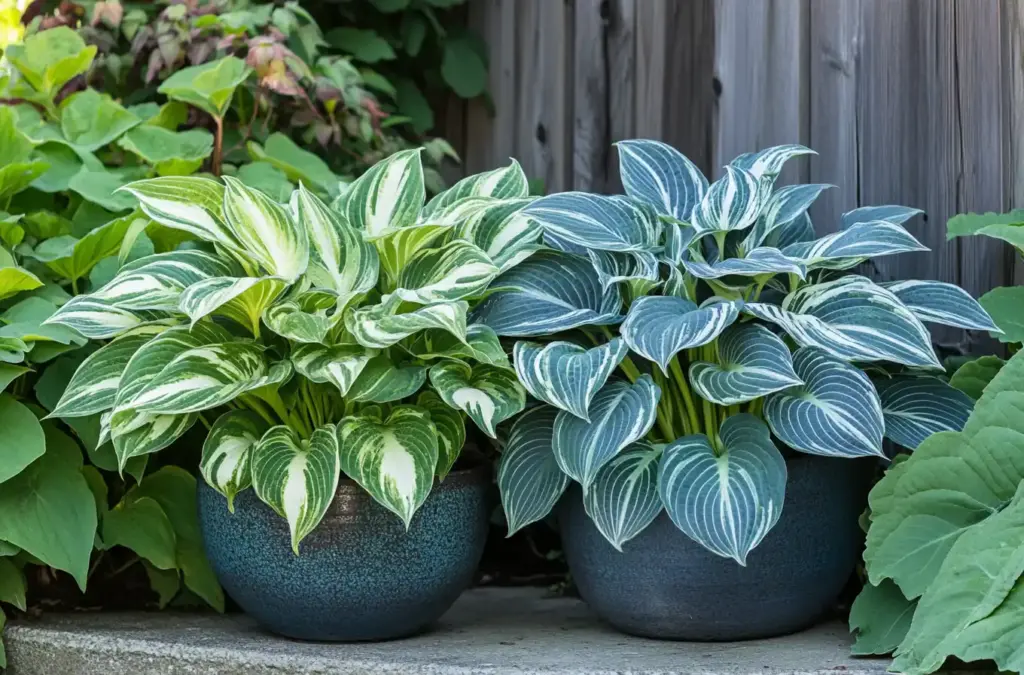
One of the joys of growing hostas in containers is the creative freedom they offer. These versatile perennials shine in both decorative and functional roles, transforming dull, shady spots into lush, eye-catching displays.
🌿 Elevate Shady Spaces
- Use potted hostas to add height and dimension in areas where in-ground planting isn’t ideal—under trees, near fences, or around seating areas.
- Place them on pedestals or plant stands to make them focal points in layered garden designs.
🏡 Enhance Outdoor Living Areas
- Flank doorways or stairs with symmetrical container arrangements.
- Use hostas to soften hardscapes on:
- Patios
- Porches
- Balconies
- Combine different leaf shapes and colors for a textural mix.
🪴 Create a Mobile Display
- Small containers can be moved easily throughout the seasons to highlight your best-looking plants.
- Rotate containers to maximize sun exposure or to swap varieties as blooms peak.
🎨 Get Creative with Miniature Varieties
Mini hostas are perfect for whimsical and compact displays:
- Plant in tea cups, birdhouses, toy wagons, or old wooden boxes
- Ideal for rock gardens or vertical arrangements
🌸 Design Tip: Pair variegated hostas with bold solid-colored companions like ferns, caladiums, or impatiens for a lush, coordinated look.
With endless container styles and placement options, hostas in containers can elevate your outdoor space from functional to fabulous.
🌿 6. Recommended Container-Friendly Cultivars
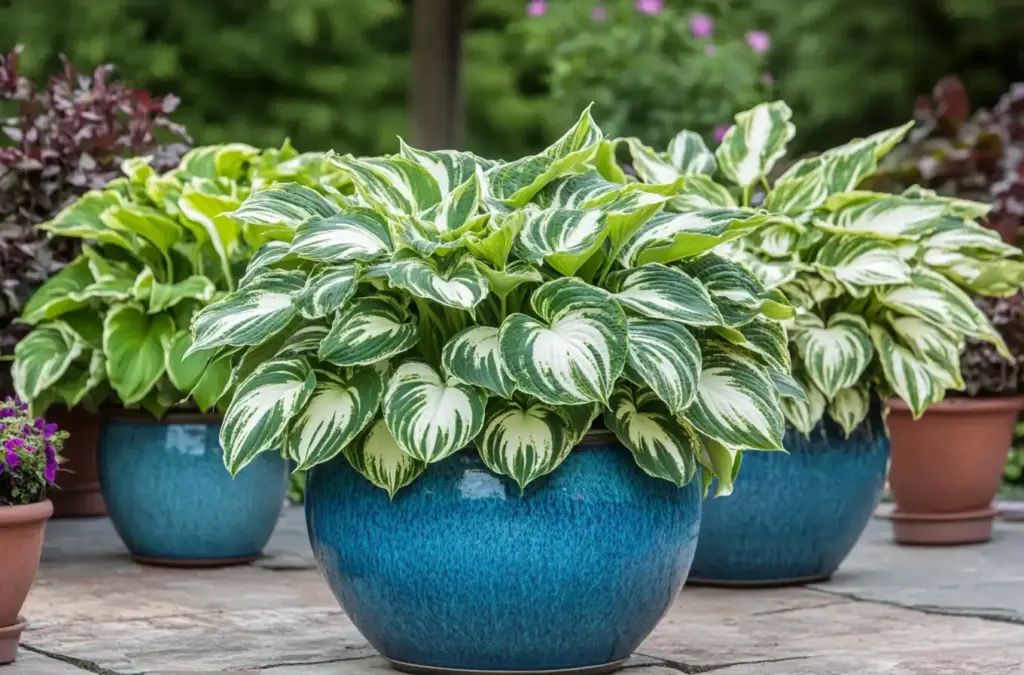
Not all hostas are created equal when it comes to container gardening. Some varieties are naturally more compact and manageable, making them ideal choices for pots and creative displays. Here are some standout picks for growing hostas in containers:
🌱 Miniature Hostas (Perfect for small pots or creative containers)
These tiny treasures are great for mugs, toolboxes, or tight spaces:
- ‘Blue Mouse Ears’ – Rounded, blue-green leaves with a tidy, symmetrical shape
- ‘Coconut Custard’ – Soft yellow foliage with contrasting purple stems
- ‘Itsy Bitsy Spider’ – Thin, wavy leaves that stay under 6 inches tall
- ‘Mini Mouse’ – A smaller cousin of ‘Blue Mouse Ears’ with similar appeal
💡 Mini hostas are perfect for fairy gardens or rockeries. Just be sure to monitor soil moisture closely.
🪴 Compact Hostas (Best for medium containers)
These cultivars offer a bigger impact while staying manageable:
- ‘Loyalist’ – Deep green leaves with bright white centers; striking contrast
- ‘White Feather’ – Unique white foliage that slowly turns green throughout the season
🌿 Medium Varieties (Best for larger containers or group plantings)
For a fuller presence in patio displays or borders:
- Shadowland ‘Hudson Bay’ – Stunning blue and cream variegation; grows about 18–24 inches tall
- ‘June’ (not on original list but worth mentioning) – Popular for its golden centers and blue margins
📦 Pro Tip: When shopping, look for varieties labeled as “dwarf” or “container-friendly” to ensure the best results in pots.
These cultivars not only thrive in pots but also provide year-round interest through unique leaf shapes, colors, and textures—making your hostas in containers a living work of art.
❓ Frequently Asked Questions About Hostas in Containers
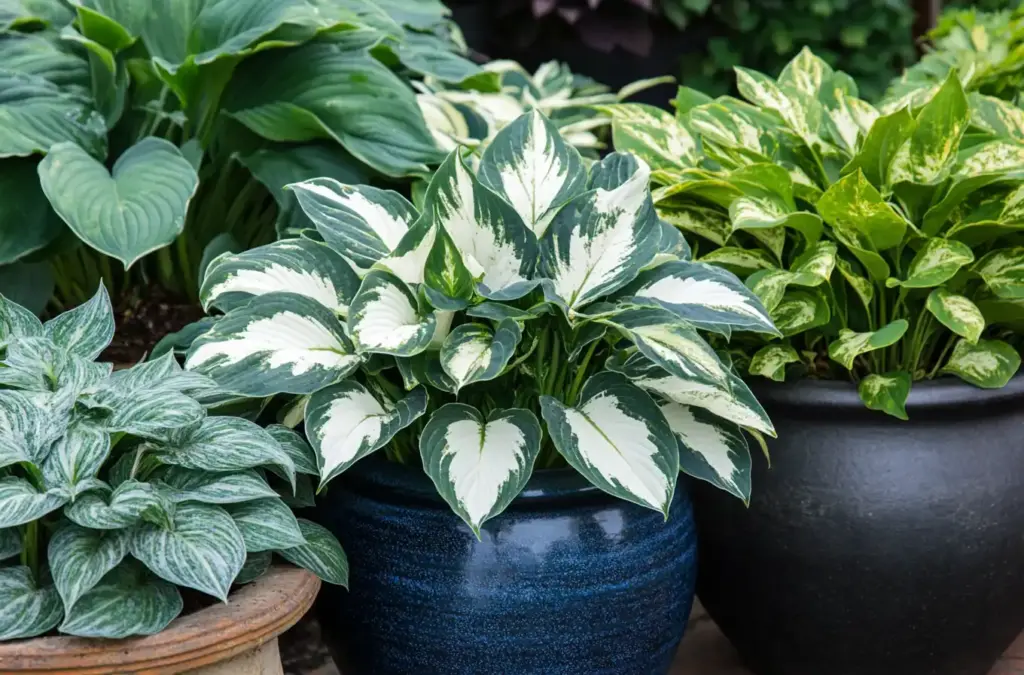
🌿 Can hostas grow well in containers?
Yes! Hostas in containers can thrive just as well as those planted in the ground, provided you use the right soil, choose an appropriate container, and water them consistently. Container planting even offers benefits like mobility and protection from certain pests.
🪴 What size container is best for hostas?
The ideal container is wider than it is deep to match the shallow, spreading root system of hostas. Ensure there is at least 3 inches of space around the plant’s base for proper root development.
💧 How often should I water potted hostas?
Water hostas in containers more frequently than in-ground plants, especially during hot weather. Check moisture levels often and water when the top inch of soil feels dry. Avoid overhead watering—target the soil line to prevent disease.
❄️ Can hostas in containers survive winter?
Yes, but they need a period of cold dormancy (below 40°F for at least a month). Either leave pots outside with protection (like pine boughs), or store them in an unheated garage or shed. Never bring them into a heated home.
🐌 Do containers prevent slugs on hostas?
Unfortunately, no. Slugs can still climb into pots, although you may have fewer issues than in garden beds. Use barriers like copper tape or organic slug repellents to protect your plants.
🌱 Do hostas need to be fertilized in containers?
Yes. Nutrients leach out of potting soil more quickly, so fertilize regularly using a slow-release or liquid fertilizer every 2–3 weeks during the growing season.
🌼 Which hosta varieties are best for containers?
Compact and miniature cultivars are best for containers. Great choices include:
- Mini: ‘Blue Mouse Ears’, ‘Mini Mouse’, ‘Coconut Custard’
- Compact: ‘Loyalist’, ‘White Feather’
- Medium: Shadowland ‘Hudson Bay’
🌿 Conclusion
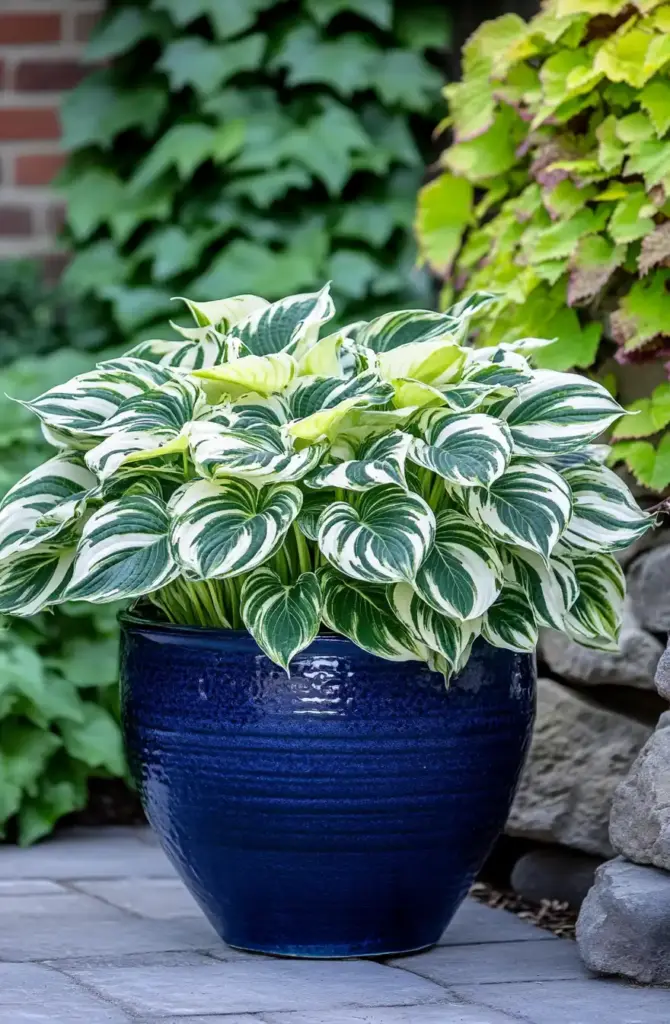
Growing hostas in containers is a wonderfully rewarding way to add year-round interest and lush texture to those shady, underutilized spots in your landscape. Whether you’re working with a compact patio, a covered porch, or a tree-shaded nook, container hostas bring both versatility and charm—especially when paired with other low-maintenance outdoor potted plants.
The key to success lies in selecting the right pot, using rich, moisture-retentive soil, and providing just the right amount of seasonal care. Even in limited space, you can turn plain corners into vibrant displays—just like in these creative porch planter makeovers that elevate small outdoor areas.
So go ahead—grab a beautiful container, choose a shade-loving hosta cultivar, and create your very own container garden sanctuary. And if you’re placing your pots on a porch, don’t miss our summer front porch décor ideas to complete the look.

